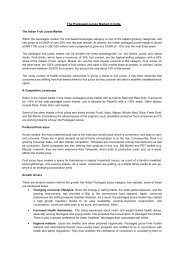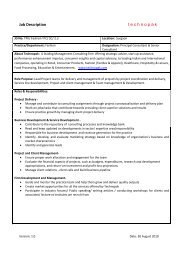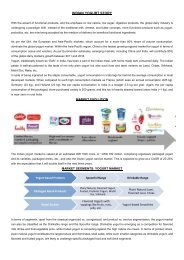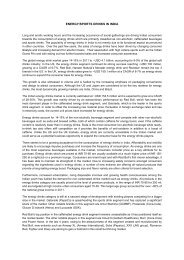The Lavish Indian Market of Imported Food & Wines - Technopak
The Lavish Indian Market of Imported Food & Wines - Technopak
The Lavish Indian Market of Imported Food & Wines - Technopak
Create successful ePaper yourself
Turn your PDF publications into a flip-book with our unique Google optimized e-Paper software.
meat products, tea & c<strong>of</strong>fee as well. Many international manufacturers are still trying to figure out the <strong>Indian</strong> market &<br />
the association with importers to introduce their product portfolio. However, the success rate is not very impressive.<br />
Many expansion & entry plans are still at hold from various companies abroad because <strong>of</strong> several constraints & chaos<br />
associated with the <strong>Indian</strong> market. Some <strong>of</strong> the key challenges faced by these international giants are:<br />
<br />
High import duties & aligned tariffs<br />
A high import duty on majority <strong>of</strong> food items along with the non-tariff barrier continues to create an obstruction<br />
for importers and manufacturers. <strong>The</strong> added cost gets transferred to the consumer & hinders the adoption <strong>of</strong><br />
imported food. <strong>The</strong> import duty structure ranges from 26% to74% for imported food & wine segment in India.<br />
Regular interventions & recommendations are made towards lowering the duties by different importers<br />
associations and trade commissions. However, the <strong>Indian</strong> government has intervened by amending the duty<br />
structure <strong>of</strong> various food items from time to time, depending upon market conditions and requirements. <strong>Food</strong><br />
inflation has also lowered some import duties resulting in an almost negligible import duty on wheat, rice, corn<br />
and crude vegetable oils. <strong>The</strong> applicable duties cover basic duty, Countervailing Duty (CVD) & Special Additional<br />
Duty (SAD) or special CVD.<br />
<br />
Lack <strong>of</strong> infrastructure support resulting in high lead time<br />
<strong>The</strong> poor infrastructure support in terms <strong>of</strong> transport & storage facility acts as one <strong>of</strong> the major laggards for<br />
imported food segment. <strong>The</strong> integrated cold chain framework is still at a nascent stage in India & the huge<br />
demand & supply gap <strong>of</strong> support infrastructure acts as a constraint in the supply chain <strong>of</strong> imported goods.<br />
<br />
Supply chain constraints blocking the reach beyond metros & mini metro<br />
Majority <strong>of</strong> India lives in rural & semi-urban areas, the supply chain constraints coupled with poor infrastructure<br />
support makes it impossible to reach such markets. <strong>The</strong> huge chunk <strong>of</strong> <strong>Indian</strong> consumers remains untapped<br />
resulting in poor growth <strong>of</strong> the segment. Factually the target segment <strong>of</strong> imported food houses in metros & mini<br />
metros, however if the support infrastructure is in place, the market can be expanded to other cities.<br />
<br />
Stringent <strong>Food</strong> laws<br />
For international manufacturers India is a land <strong>of</strong> stringent food laws which makes it very difficult to enter &<br />
sustain in the <strong>Indian</strong> market. Various Ministries abide by various rules & regulations to ensure entry &<br />
availability <strong>of</strong> safe products for the consumers. Exporters have to follow an array <strong>of</strong> food laws covering use <strong>of</strong><br />
additives and colors, labeling requirements, packaging, weights and measures, shelf-life and phyto-sanitary<br />
regulations. To consolidate different laws pertaining to food & aligned products, Government <strong>of</strong> India has<br />
framed “<strong>Food</strong> Safety and Standards Act, 2006” (FSSA). It concentrates on consolidating various food laws and<br />
works as single regulatory agency in place <strong>of</strong> current multiple regulatory agencies.<br />
<br />
Diverse food habits across the nation<br />
<strong>Food</strong> is like a religion in India, the different cultures make it a home for an array <strong>of</strong> cuisines. <strong>The</strong> nation is known<br />
for diversified & distinct food habits throughout the globe. <strong>The</strong> assorted food habits work as an opportunity as<br />
well as a challenge for food manufacturers sitting abroad. Customizing the product <strong>of</strong>fering according to the<br />
<strong>Indian</strong> platter has gained popularity in recent times, but the same is limited to food services. Catering to the<br />
diversified food habits & fulfilling the expectations in terms <strong>of</strong> quality & affordability will remain as a laggard for<br />
the imported food segment in India.















